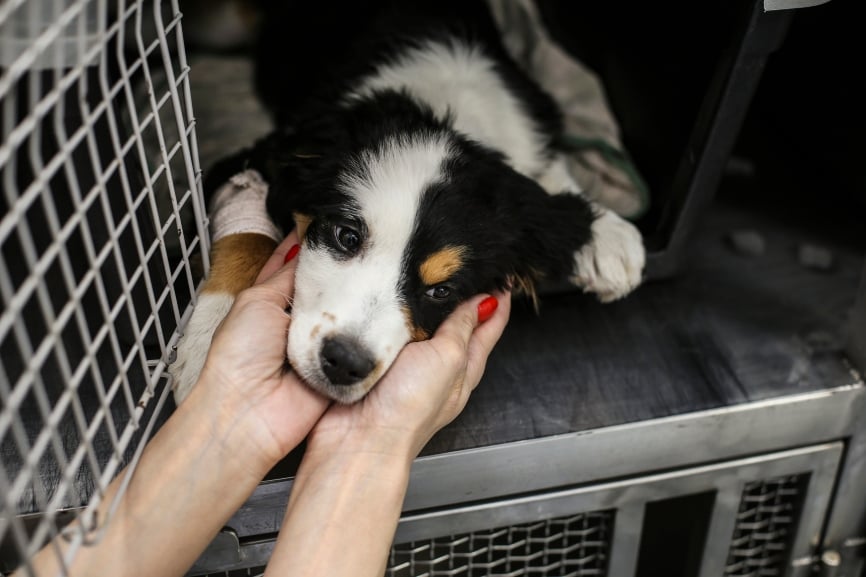Every day, it seems there’s a new pup missing – Facebook, news stations and even Instagram are full of “LOST DOG” stories. But the culprit behind these disappearances isn’t canine wanderlust, it’s pet theft. According to adoption website PetFinder, over 2 million pets are stolen every year.
While most incidents of pet theft are random and done by determined thieves, there are some precautions you can take.
1. Don’t leave pets unsupervised outside.
sEven if your dog is in a fenced, dog-friendly yard, some pet thieves won’t be deterred. In a Modern Dog magazine story, pet parent Ella Jones described how her Husky, Keymo, was stolen in a matter of minutes. “A co-worker gave him to me from her litter and the first time I saw him, I loved him,” she said. “He was a companion, he was like my child and I just want him back home.”
We’re not saying put Fido on house arrest, but avoid leaving pets outside when you’re not home. When it’s time for potty breaks or outside time, keep your dog within eyesight. Never allow your pet to wander unleashed – it’s dangerous for you, your pet and other dogs.

2. Microchip your pet.
The American Veterinary Medical Association (AVMA) found that 52 percent of microchipped dogs made it back home – only 22 percent without microchips do. Especially after this eye-opening figure, microchipping your pet is essential! Most animal shelters microchip as part of a pet’s adoption process.
Microchips are no bigger than a grain of rice, and are inserted painlessly under your pet’s skin. The chip contains a unique identifying number, which – when registered – will display pet parents’ contact information after scanning. However, the AVMA’s study also found that only 58 percent of microchips are registered with this information, making them much less useful.
If you move or change phone numbers, update your pet’s microchip information! Some shelters will automatically activate the microchip using the address and number provided by you, while others simply insert it blank. If you’re not sure, ask! If your pet doesn’t have a microchip, contact your local animal shelter; many have low-cost or free microchipping events.

3. Secure your yard.
We can’t watch our pets 24/7, despite our best efforts. Adding security to your yard can prevent pet theft by deterring would-be burglars. Padlock gates and ensure fences are high enough that you dog can’t be seen from the street. Watch for weak spots in and under your fence, which can allow Fido to get out or unfriendlies to get in. There are many ways to dog-proof a fence, from blocking off diggable spots to adding an extension.
Pet theft is a crime of opportunity – nine times out of ten, if a puppy-napper can’t gain easy access to your pet, they’ll give up.
4. Stranger danger!
If you notice anyone unusual or out of place in your neighborhood, be wary. Potential pet thieves often canvas a neighborhood first, sometimes even approaching pet parents on walks with their dogs. Anyone who seems interested in your pet solely for their breed or age should get a red flag.
Any suspicious behaviors – including people looking into yards, strange cars loitering outside a home – should be reported to the police or neighborhood watch. If you know your neighbors, talk to them about your suspicions too.
5. Spay or neuter your pet.
While this may seem unrelated to pet theft, animals who are unaltered are more likely to escape and be picked up by thieves. When dogs are in heat, they’ll do anything to find another pet – including jump and dig under fences.
There are also numerous health benefits to spaying or neutering, but as it applies to pet theft, it’s for Fido’s own good! Contact local animal shelters for information about low-cost or free alteration.

6. Don’t leave pets unattended in public.
We’ve all tied up our pet outside a coffee shop or left Fido in the car for a quick errand, but these events leave your pet vulnerable to theft. If you must visit a not-pet-friendly restaurant, ask for seating outside or get a pet sitter.
Avoid leaving pets in cars at all costs, especially during the summer and winter. If you absolutely must keep your dog in the car, limit trips to under 10 minutes and keep the windows cracked. However, if your dog is a barker, don’t leave him unattended at all – the noise may attract attention from admirers, the annoyed, and pet thieves alike.
7. Pick a pretty collar!
When trying to find your lost or stolen pet, it helps to mention distinctive features he or she might have. Birthmarks, multi-colored eyes, a funny ear – even a distinctive collar or tags. Pick a collar that’s brightly colored or patterned. In addition to your pet’s vaccination or microchip tags, the collar should contain one with your pet’s name and your phone number.
Pet supply stores often have engraving machines with variety of colored or uniquely shaped dog tags. There are also companies online or even animal shelters who can produce custom dog tags.
If you love your pets like family, protect them like family by enrolling in pet insurance. You can say “yes” to important treatments and save up to 90% on vet bills. Bonus: by getting a free quote, you also help to donate to a homeless pet’s medical care.








